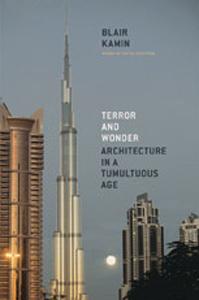Terror and Wonder: Architecture in a Tumultuous Age, by Blair Kamin ’79, P’15 (University of Chicago Press)
Reviewed by Rand Richards Cooper ’80
 |
[Nonfiction] Architecture, Ludwig Mies van der Rohe famously observed, is the will of an epoch translated into space. Bastard child of art and science, it mixes the ideal with the real, forcibly yoking the flight of fancy to the bottom line. Attend a meeting of the players in a big building project and you’ll meet visionaries and design geeks, construction bosses, developers and city officials. Their new buildings capture the zeitgeist in concrete and steel, and in the process raise a tantalizing chicken-and-egg question: Does architecture reflect who we are or create who we are?
For two decades, Pulitzer Prize-winning architecture critic Blair Kamin has been casting an astute eye on urban environments for the Chicago Tribune. Terror and Wonder fashions his articles into a reflection on the first decade of the new millennium, seen through the lens of design. Kamin addresses five broad topics: the rebuilding challenges posed by 9/11 and Hurricane Katrina, the housing boom, the nature and meaning of iconic buildings, the rise of green architecture and the problems posed by our deteriorating infrastructure. Despite the occasional excursion to other locales (such as Dubai and its colossal Burj Khalifa megascraper), Terror and Wonder is highly Chicago-centric. This befits the city’s key role in the development of modern architecture and the skyscraper in particular—and its avid participation in the last decade’s building boom, with scores of new high-rises reshaping its skyline.
Too many of these structures, in Kamin’s judgment, are failures—“monuments to mediocrity” put up by developers and builders bent on “the uglification of Chicago.” Kamin skewers insipid buildings, describing one recent apartment high-rise as “a hulk designed in the colors of a Creamsicle.” Condemning much new construction as “irreversible visual carnage,” he imputes near-criminality to the perpetrators of bad design: “the barons of real estate,” wielding their spreadsheets like cudgels, and the corporate architects who do their bidding. “Asking today’s hacks to do unique, world-class buildings,” he scoffs, “is like handing firecrackers to a four-year-old.”
You can disagree with Kamin’s judgment on this or that structure. (I confess to liking Daniel Wohlfeil’s 50th-anniversary showcase McDonald’s, which Kamin finds “grotesque.”) Yet the barbs let loose in Terror and Wonder are intended to prick a larger target—namely, “the architect’s responsibility to design for the broader public as well as the client.” A superb reader of individual structures, Kamin never loses sight of the bigger picture, insistently asserting the link between aesthetics and politics. Surveying, in a 2005 article, the glut of new branch banks built to service the loan boom, he finds them “disappointingly faceless”—mirroring the perilous anonymity that defined mortgage securitization. Bad buildings, bad business.
Every critic, even (or perhaps especially) a scathing one, needs his touchstones of quality. Worshiping such past and present masters as van der Rohe and Frank Gehry, Kamin also admires younger and lesser-known architects. In Chicago he singles out Ralph Johnson’s Le Corbusier-inspired condo building, The Contemporaine, and the spectacular 82-story high-rise, Aqua, by Jeanne Gang, whose irregularly placed, amoeba-shaped balconies, viewed from below, suggest a mesmerizing cascade of waves.
Kamin’s book takes us on an enthusiast’s tour of some of the decade’s most brilliantly executed new structures. Yet though he thrills to such iconic public buildings as Santiago Calatrava’s addition to the Milwaukee Art Museum, with its avian, steel-winged superstructure, or Gehry’s Disney Concert Hall in Los Angeles—“a musical ark with silver sails”—he balances his enthusiasm with hardheaded cost-benefit assessments. What good is it if cities saddle themselves with so much debt to build these iconic buildings that they have to cut staffing in order to pay it off? And not all of these spectacle buildings succeeded at drawing the masses. “If you built it,” Kamin notes mordantly, “they didn’t necessarily come.”
Terror and Wonder discerns a moral arc in the decade’s architecture: the spectacular excesses of the boom years, a rude comeuppance and then a chastened and sensible correction by way of sustainability. Kamin’s closing chapters look to the future, praising new museums, such as Renzo Piano’s California Academy of Sciences, that abjure the spectacular in favor of “vying to be more virtuous—as in green.” Kamin takes the election of Obama as “a chance to start a civic conversation about how we live, how we grow.” Sounding distinctly Obamaesque himself, he congratulates the architects, engineers and officials in Chicago who had “the courage to imagine” a redo of Wacker Drive, creating a new riverfront plaza that has quickly become a galvanizing public space. Better design really does make cities more livable.
If I have a reservation about Terror and Wonder, it arises—appropriately enough—from its form. Kamin’s mind is expansive, yet newspaper criticism is anything but. I’d like to hear him set free to build large. Nevertheless, this is a genial and wide-ranging book. Lucid, sensible, in equal parts skeptical and rapt, Kamin is all you could hope for in a commentator. Though trained at the Yale School of Architecture, he is never aridly aesthetic, but rather keeps reminding us that design is a social phenomenon. “We are what we build,” he observes. “We build what we are.”
Terror and Wonder delivers a mixed architectural verdict on an American moment in which “[p]rivate splendor and public squalor were two sides of the same coin.” A wary optimist, Kamin looks back at a turbulent decade and finds, amid the banal and the meretricious in the built environment, redemptive works of genius— “gems,” he writes, “that promised to light the way down a brighter path.”
Rand Richards Cooper wrote the Winter 2011 Amherst magazine cover story on longtime Manhattan district attorney
Robert Morgenthau ’41.